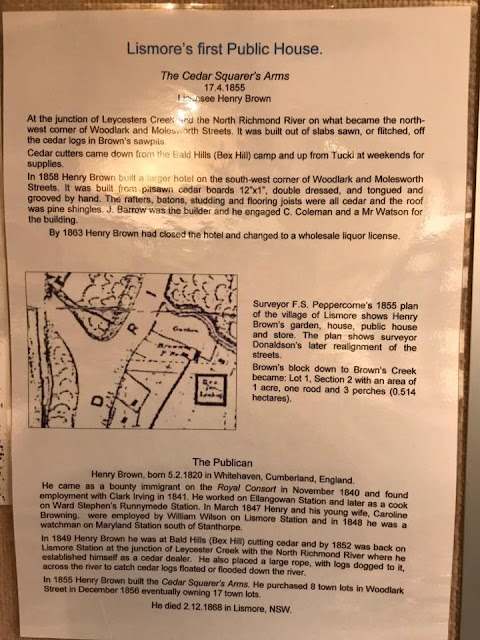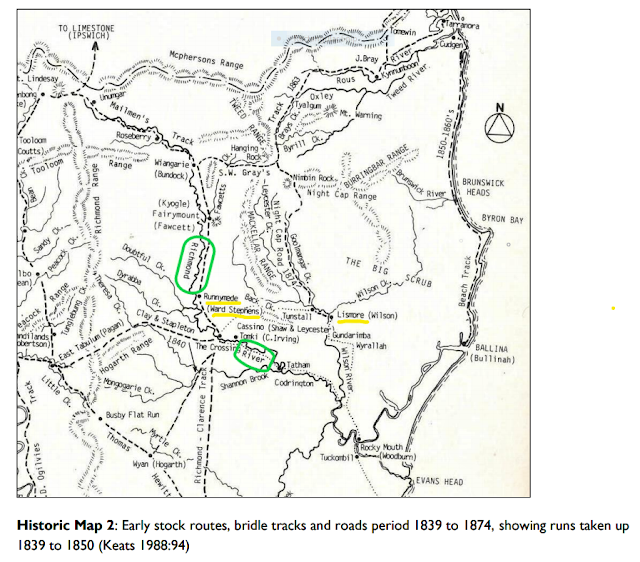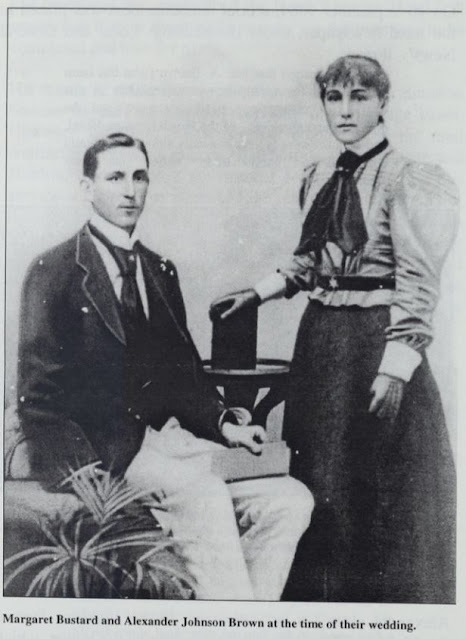My post this week tells the story of the oldest sons of my Great Great Grandmother, Caroline Penelope Brown/Taylor/Collins nee Browning and her first husband, my Great Great Grandfather, Henry Johnson Brown.
Caroline, aged 15, and Henry, aged 25, married in 1846 and were married for 22 years, until Henry's death. The details of Caroline's and Henry's eldest children were very sketchy when I began researching the family, and it's taken me a while to work it out. It was all a bit of a riddle to start with.
Of course, given that Caroline and Henry lived rather a nomadic life at the beginning of their marriage (with both of them working as shepherds to start with, then living the life associated with Henry's work as a hawker and a cedar cutter), official records are few and far between, so I've had to rely on other sources of information.
I started with evidence from the death certificates of both my 2x great grandparents. There was however a mismatch straight away. One death certificate listed what looked like 11 children, and the other listed 12.
 |
| Extract from death certificate for Henry Johnson Brown |
Looking firstly at my 2x great grandfather's death certificate, dated 1848, was not all that helpful.
11 children were recorded but no names were listed and no ages which would have been helpful in working out years of birth.
The informant was a clerk named Chatfield and as far as I know, he didn't have an intimate knowledge of Henry's family members.
12 children were recorded on 2x great grandmother Caroline's death certificate, dated October 1894.
All the children's names were listed, apart from two males who were identified as deceased at that time, and the respective ages of those children still living. Far more helpful!
The informant for Caroline's death certificate was a family member. It was her son-in-law Robert Gall, wife of her daughter Eliza, who provided this information. Caroline was living in their home when she died and had been living with them for some time.
As a result, I was more inclined to believe that Caroline and Henry actually had 12 children together.
One of those children listed on Caroline's death certificate was a son named Alexander Brown, who was known as Sandy for most of his lifetime (I have no idea why!) and he was listed as the eldest, so I originally thought he might be the first born.
I came across an article which seemed to back up this assumption. One of Caroline's and Henry's sons, John Thomas Brown, was interviewed for an article in the Lismore newspaper, The Northern Star, many years later. He stated that a boy had been born in March of 1847. His words were "my brother Sandy was born on that night." Sandy was the nickname for Alexander Brown, so this recount seems to indicate the first born was indeed Alexander.
I immediately spotted an issue with the dates contained in that article though. If Alexander had actually been born in 1847, he would have been older than the age listed on Caroline's death certificate, as seen above.
Another piece of evidence was an obituary printed upon Alexander's death which indicated that he had been born in 1846 in Lismore, New South Wales. That didn't match with the age listed on the above death certificate either.
I continued my search and came across two other sources of information
Another article I found, titled "The Late Alexander Brown", was printed in The Northern Star in 1931 and stated that "he was born near Casino in 1844, whilst his parents were travelling in a waggon to what is now known as Lismore, but which was then virgin scrub."
1844? That didn't match the age listed on his mother's death certificate either.
If he was born in 1844 his mother would have been giving birth at the age of 13! Unlikely!
Even Alexander himself, when writing a letter to the editor of The Northern Star, dated September 1924, stated "I may further state that I was born on March 11, 1847."
He was claiming to be the oldest white born person in the Lismore district at the time, and indeed in the town of Lismore itself.
This letter was written to contradict the fact that another man named Mr. J. Greenhalgh had been identified as the first born in the district and had been introduced to the Governor as such.
You would assume that a person would know their correct birth date, so if Alexander stated it was March of 1847, wouldn't that be correct?
Well a problem with all this information I had found up to this point became apparent when I then went on and found a baptism record for Alexander. His parents had indicated his date of birth as March 9th, 1849 on the official record of baptism.
Alexander was not baptised until a year after his birth, in 1850 and he was baptised in the Burnett District which was much further north of the Lismore district.
This ties is much more accurately with the information about Henry's working life at that time.
After Alexander's parents had left Runnymede to work at Lismore Station, it seems that they had moved again within a year. By March of 1848 they were working on Maryland Station, a 200,000 acre property on the Darling Downs owned by Matthew Marsh. At that time the area was still part of New South Wales, but was quite a long way north of Lismore. Alexander's father Henry also worked as a 'hawker' during this time and continued on with this until at least 1850. The family was travelling around the Burnett District at this time, and this is how the family had ended up in the Parish of Brisbane for Alexander's baptism, which was at that time part of northern New South Wales.
So it appears that Alexander's parents Caroline and Henry were living a nomadic lifestyle in the far north of New South Wales when Alexander was born, and that he had actually been born in 1849, contrary to all that other supposedly reliable information. The family was not living anywhere near the Lismore district again until early 1850, when they moved back to the Richmond River area to Bald Hill (later named Bexhill) where Henry started working as a timber cutter.
The question remained however ... was there a son born in 1847 who was the real subject of that story told by John Thomas Brown? You know ... the story about a son being born while Caroline and Henry were on the move from Runnymede?
Further research, which included reading the valuable book The Browning Story: Tracings From The Past written by Esme Smith, along with examination of information from other Ancestry.com family trees, and the searching of FamilySearch.com and Ancestry.com databases, led me to believe that Caroline's and Henry's first child was indeed a son, named after his father, and born in 1847 whilst they were leaving Ward Stephen's 128,000 acre property at Runnymede.
According to information found on both FamilySearch.com and Ancestry.com, Henry Johnson Brown Jnr. was the son born in March of 1847 (not Alexander).
According to these records, Henry Jnr's birth place was recorded as 'Richmond River' (Runnymede Station was located along the river) where his parents were working as shepherds.
It was at this point that Caroline and Henry Snr. decided to leave Runnymede and seek employment with Mr. Wilson on his 23,000 acre Lismore Station located along the Wilson River.
Caroline, nine months pregnant, and her husband Henry made their way on foot to the Wilson property and the story of their first-born son's birth was in fact exactly as told by his brother John Thomas Brown many years later in a newspaper article.
Note: I have already established that the son mentioned in this article could not have been Sandy (Alexander) as stated, but Henry Jnr.
Henry Johnson Jnr. was apparently baptised in the Clarence River District a month later, which means his parents were on the move once again and this coincides with the information I previously mentioned about my great great grandparents leaving the Richmond River area to work at Maryland Station.
Sadly, Henry Johnson Jnr. seems to have died sometime the following year, in 1848, and I know for sure his father was working as a watchman on Matthew Marsh's Maryland Station at that time, but would then go on to become a 'hawker' towards the end of 1848. Henry Johnson Jnr. would then be one of those two children listed on his mother's death certificate as deceased.
So ... jump ahead another couple of months and Alexander Johnson Brown was born in March of 1849, which would make him the second born son of my great great grandparents.
Apart from the period in his very early life between 1849 and 1850 when his parents were moving around quite a lot in search of work, Alexander lived his life mostly in Lismore, New South Wales.
At the age of 22, he married his cousin Margaret Jane Bustard.
They were married in November of 1871 at McLeod's Creek in New South Wales, and went on to have twelve children, all born in the Lismore district.
In the very early days of his marriage, Alexander worked "as a timber cutter and as an agent looking for the best timbers available for the market." ('The Browning Story: Tracings From The Past' by Esme Smith p. 92), as had his father before him.
This did not last however, as Alexander became a publican towards the end of 1884. This was again exactly the pattern of his father, who established the first public house / hotel in Lismore.
Alexander was the publican of the North Lismore Hotel for only a few years, before becoming the proprietor of the Bridge Hotel. He did not continue working as a publican for long after that though, and by 1891 he was employed as the mail contractor between Lismore, Blakebrook, Goolmangar and Nimbin.
Alexander's and Margaret's children were born between 1872 and 1896.
Elizabeth Margaret was born in 1872.
Henry Johnson came along in 1874.
Mary Ann was born in 1876, but sadly died the following year.
Charles was born in 1878.
Alexander Jnr. was born in 1879.
Martha Jane came along in 1882.
Tempest was born and died in 1885.
Sarah (known as Sadie) was born in 1886.
Mabel came along in 1889.
Sydney was born in 1891.
Bertha Stella in 1893 and
Curtis was born in 1896.
This family photo taken in 1929, when Alexander was aged 80 and his wife (seated in the middle of the photo) was 75, includes their daughter Sarah (back row far left) and their grandchildren Eric, Alan, Hilton (known as Bill) Keith, Mabel, and Dorothea. The other girl is unknown.
It would seem that Alexander and his wife Margaret had quite a close and happy relationship during their almost 60-year marriage. Sadly, Margaret died in March of 1931 and upon her death, Alexander reportedly stated: "that he would like to go with her and it would not be long."
It was in fact a mere five months later that Alexander Johnson Brown died, aged 82. Both had died just months before their 60th wedding anniversary.
An obituary (mentioned before) stated that:
"All that long life he had lived in the district, working hard to rear his family, and having a full share of the ups and downs of life. Beneath a somewhat rugged exterior there was hidden a gentleness and kindness which brought him high regard."
"Personally, I shall cherish his memory as one of the worthy pioneers - as a hard worker, a good husband, a generous father, and as a man of common sense. He set a good example to all around him. At 85 he was loved by all who knew him and then the race was over."
Interestingly, in an article mentioned previously, 'The Late Alexander Brown: Lismore's First White Child' printed at the time of his death, the reporter Mrs. Margaret Kearney stated:
"Alexander (or Sandy) Brown, as he has always been called, had an intimate knowledge of dialects of every aboriginal tribe from the Tweed to the Clarence ... This stood him in good stead when buying as agent in search of the best cedar patches in the giant scrub. He was able to converse with each tribe in his own dialect, and had a great advantage over trade competitors."
Alexander and his wife Margaret were survived by ten of their children, although their daughter Sarah, known as Sadie, died just three months after the death of her father.
















No comments:
Post a Comment